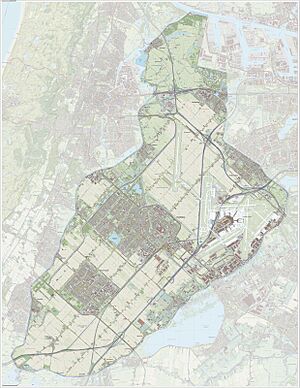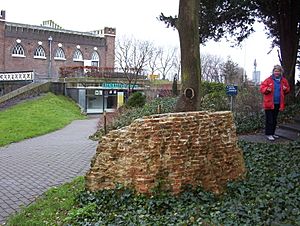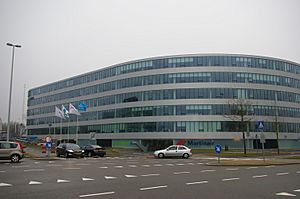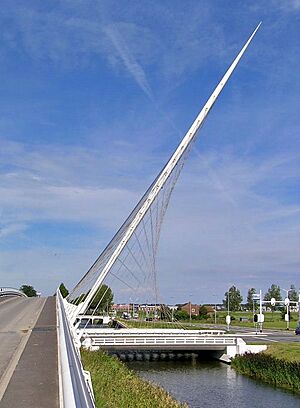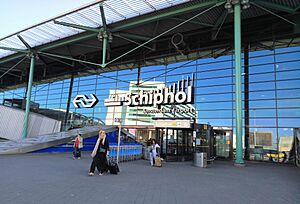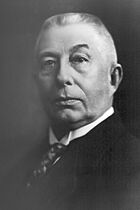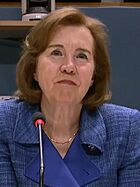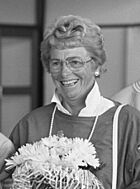Haarlemmermeer facts for kids
Quick facts for kids
Haarlemmermeer
|
|||
|---|---|---|---|
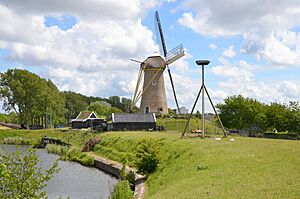
Windmill in Hoofddorp
|
|||
|
|||
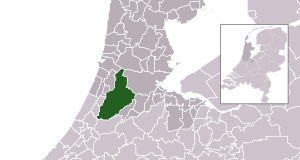
Location in North Holland
|
|||
| Country | Netherlands | ||
| Province | North Holland | ||
| Region | Amsterdam metropolitan area | ||
| Government | |||
| • Body | Municipal council | ||
| Area | |||
| • Total | 185.29 km2 (71.54 sq mi) | ||
| • Land | 178.66 km2 (68.98 sq mi) | ||
| • Water | 6.63 km2 (2.56 sq mi) | ||
| Elevation | −4 m (−13.1 ft) | ||
| Population
(May 2014)
|
|||
| • Total | 144,226 | ||
| • Density | 807/km2 (2,090/sq mi) | ||
| Demonym(s) | Haarlemmermeerder | ||
| Time zone | UTC+1 (CET) | ||
| • Summer (DST) | UTC+2 (CEST) | ||
| Postcode |
Parts of 1100, 1400, 2000 and 2100 ranges
|
||
| Area code | 020, 023, 0252, 0297 | ||
Haarlemmermeer is a municipality in the western part of the Netherlands. It is located in the province of North Holland.
Haarlemmermeer is a special type of land called a polder. This means it is land that was once underwater, but has been reclaimed or drained. The name Haarlemmermeer means 'Haarlem's lake'. It refers to the large body of water that was drained in the 19th century to create this land.
The main town in Haarlemmermeer is Hoofddorp, which has over 76,000 people. Other growing towns include Nieuw-Vennep and Badhoevedorp. These towns are part of a large urban area called the Randstad. The main international airport of the Netherlands, Schiphol, is also located here.
Contents
History of Haarlemmermeer
The area that is now Haarlemmermeer was once a large lake. It started as a peat bog, which is a type of wetland. Over time, several smaller lakes joined together because of floods. These floods caused villages to disappear under the water. One such village was Vennep, which gave its name to the modern town of Nieuw-Vennep.
The Dutch call this tendency for lakes to grow the "waterwolf". The Haarlemmermeer was a dangerous place, especially during storms. In 1629, a prince named Frederick Henry drowned while trying to cross it. By 1647, the lake had grown to about 150 square kilometers.
People had thought about draining the lake for a long time. Jan Leeghwater suggested it in 1643. But it wasn't until two very strong storms in 1836 caused huge floods that the idea was taken seriously. One storm pushed the lake's water almost to Amsterdam. Another storm flooded the streets of Leiden.
In 1837, King William I set up a special group to study the problem. Their plan was approved in 1839, and work began in May of that year.
Draining the Lake
First, a large canal was dug all around the lake. This canal is called the Ringvaart (Ring Canal). It was built to carry away water and allow boats to travel, as they could no longer cross the lake directly. The canal was 61 kilometers long and 2.4 meters deep. The earth dug out was used to build a wide dike around the lake.
The area inside the canal was over 180 square kilometers. The lake was about 4 meters deep on average. Since the water had no natural way to drain, engineers calculated that a billion tons of water would need to be pumped out.
This huge task was done using steam engines, which was a new technology at the time. Before this, windmills were used to drain polders. Three large steam engines were brought in from England. They were named the Leeghwater, the Cruquius, and the Lijnden. The Cruquius engine was the largest steam engine of its kind ever built.
Pumping started in 1848, and the lake was completely dry by July 1, 1852. About 800 million tons of water were removed. The land was then sold. The money from selling the land covered the cost of the project.
Becoming a Municipality
In 1855, Haarlemmermeer officially became a municipality in the province of North Holland. Its first mayor was Matthijs Samuel Petrus Pabst. The first church was built in the same year. By 1860, about 7,237 people lived there. By 1900, the population had grown to over 16,000.
At first, farming was the main activity in Haarlemmermeer. Life was hard for farmers because a few rich landowners owned most of the land. After 1900, things got better. Farmers started to own their own land, and greenhouse farming became popular. Many workers moved to the area, helping the population grow.
Today, Haarlemmermeer has many large industrial areas and offices, especially in Hoofddorp and around Schiphol Airport.
In 1917, a military airport was built near an old fort called Schiphol. This airport grew into Schiphol Airport, which is now a major international airport. It uses about 15% of Haarlemmermeer's land. The name Schiphol means "ship hole". It refers to the many ships that were lost in the lake during storms before it was drained.
In 2019, the municipality of Haarlemmerliede en Spaarnwoude joined with Haarlemmermeer.
Towns and Villages
The municipality of Haarlemmermeer includes many towns and villages, such as:
- Aalsmeerderbrug
- Abbenes
- Badhoevedorp
- Beinsdorp
- Boesingheliede
- Buitenkaag
- Burgerveen
- Cruquius
- De Hoek
- Haarlemmerliede
- Halfweg
- Hoofddorp
- 't Kabel
- Leimuiderbrug
- Lijnden
- Lisserbroek
- Nieuwe Meer
- Nieuwebrug
- Nieuw-Vennep
- Oude Meer
- Penningsveer
- Rijsenhout
- Rozenburg, North Holland
- Schiphol
- Schiphol-Rijk
- Spaarndam (partly)
- Spaarnwoude
- Vijfhuizen
- Vinkebrug
- Weteringbrug
- Zwaanshoek
- Zwanenburg
Places to Visit
Haarlemmermeer has interesting places to visit:
- Stelling van Amsterdam – This is an old defense line that protected Amsterdam. Parts of it cross Haarlemmermeer. You can visit some areas for recreation, like the Haarlemmermeer Woods.
- Haarlemmermeer Woods (Dutch: 'Haarlemmermeerse Bos') – This is the largest public park in Haarlemmermeer. It was the site of a big garden show called Floriade 2002. The park has a large lake for swimming and a 40-meter tall man-made hill called Spotter's Hill. It also hosts events like horse shows and the Mysteryland music festival.
- Museum De Cruquius – This museum is located in one of the original steam mills that pumped the Haarlemmermeer dry. You can see a demonstration of the huge steam engine and learn about the Netherlands' water systems. The Cruquius steam engine is the largest ever built, making the museum an important historical site.
Economy and Business
Because Amsterdam Airport Schiphol is in Haarlemmermeer, many airlines and aviation-related companies have their main offices here.
- Four airlines: TUI fly Netherlands, KLM Cityhopper, Martinair, and Transavia have their main offices on the airport grounds.
- The airline group SkyTeam also has offices in the World Trade Center building at Schiphol Airport.
- Schiphol Group, the company that runs the airport, has its main office there too.
- Other companies like Iran Air and Nippon Cargo Airlines have offices in the area.
- Corendon Dutch Airlines has its main office in Lijnden, Haarlemmermeer.
- The Civil Air Navigation Services Organisation (CANSO), which represents air traffic controllers, has its headquarters at Schiphol Airport.
Getting Around
Roads
Several major freeways cross Haarlemmermeer. The A4 connects Amsterdam to The Hague. The A5 goes from Hoofddorp to Amsterdam Sloterdijk. The A9 connects Alkmaar to Diemen, and the A44 goes from Nieuw-Vennep to Wassenaar.
Calatrava Bridges
In 2004, three unique bridges designed by the Spanish architect Santiago Calatrava were opened. These bridges cross the main canal of Haarlemmermeer. They are named after three string instruments: the Harp, the Cittern, and the Lute.
Air Travel
Amsterdam Airport Schiphol, the main international airport of the Netherlands, is located right in Haarlemmermeer.
Train Travel
Nederlandse Spoorwegen, the Dutch National Railways, serves the municipality with three train stations:
- Hoofddorp
- Nieuw-Vennep
- Schiphol Airport (which also serves high-speed trains)
In the early 1900s, there was a network of local steam railways in Haarlemmermeer, known as the Haarlemmermeer railway lines.
Waterways
The Ringvaart (Ring Canal) is an important waterway for both commercial and recreational boats. It is part of a route that allows ships with tall masts to travel. There is also a connection to the Kaag Lake system (Kagerplassen).
Inside Haarlemmermeer, there are other canals like the Hoofdvaart (Main Canal) and Kruisvaart (Cross Canal). These canals were once used for shipping goods. In 1895, a special canal lock was built at Aalsmeer to connect them to outside waterways, which helped the local economy. However, this lock was closed in the 1950s, and the inner canals are no longer used for large ships.
Sister Cities
Haarlemmermeer has special connections with other cities around the world, called "sister city relationships":
|
To celebrate these friendships, two structures in Hoofddorp are named after the sister cities: the Cebu Citybridge and the Hódmezővásárhely fountain.
Famous People from Haarlemmermeer
Many notable people have connections to Haarlemmermeer, including:
- Hendrikus Colijn (1869–1944) – A Dutch politician who served as Prime Minister of the Netherlands multiple times.
- Gerrit Verkuyl (1872–1967) – A scholar who translated the New Testament into Greek.
- Tom Gehrels (1925–2011) – A Dutch-American astronomer and professor.
- Jan van Houwelingen (1939–2013) – A Dutch politician who was Mayor of Haarlemmermeer.
- Tineke Netelenbos (born 1944) – A retired Dutch politician who also served as Mayor of Haarlemmermeer.
- Rick van der Linden (1946–2006) – A Dutch composer and keyboard player.
- Jacob Wit (1952–2024) – A judge for the Caribbean Court of Justice.
- Cas Jansen (born 1977) – A Dutch actor.
Sports Stars
- Fanny Blankers-Koen (1918–2004) – A famous Dutch track and field athlete who won four gold medals at the 1948 Summer Olympics.
- Daphne Jongejans (born 1965) – A retired diver who competed in three Summer Olympics.
- Edwin Jongejans (born 1966) – A retired diver who competed in the Olympics.
- Michiel Bartman (born 1967) – A former rower who won gold and silver medals at the Olympics.
- Marcel Keizer (born 1969) – A Dutch football coach.
- Mitchell Donald (born 1988) – A professional footballer.
- Renate Jansen (born 1990) – A Dutch female international footballer.
- Calvin Stengs (born 1998) – A Dutch professional footballer.
- Sven Botman (born 2000) – A Dutch professional footballer.
- Rinus VeeKay (born 2000) – A Dutch racing driver.
- Déron Payne (born 2002) – A Dutch professional footballer.
See also
 In Spanish: Haarlemmermeer para niños
In Spanish: Haarlemmermeer para niños



